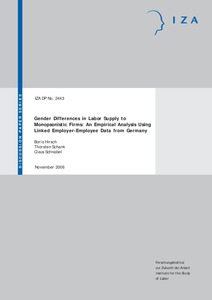Gender differences in labor supply to monopsonistic firms: an empirical analysis using linked employer-employee data from Germany
"This paper investigates women's and men's labor supply to the firm within a structural approach based on a dynamic model of new monopsony. Using methods of survival analysis and a linked employer-employee dataset for Germany, we find that labor supply elasticities are small (0.9-2.4)...
| Main Authors: | , , |
|---|---|
| Institution: | ETUI-European Trade Union Institute |
| Format: | TEXT |
| Language: | English |
| Published: |
Bonn
2006
IZA |
| Subjects: | |
| Online Access: | https://www.labourline.org/KENTIKA-19293953124910111359-Gender-differences-in-labor-su.htm |
| Summary: | "This paper investigates women's and men's labor supply to the firm within a structural approach based on a dynamic model of new monopsony. Using methods of survival analysis and a linked employer-employee dataset for Germany, we find that labor supply elasticities are small (0.9-2.4) and that women's labor supply to the firm is substantially less elastic than men's (which is the reverse of gender differences in labor supply usually found at the level of the market). One implication of these findings is that the gender pay gap could be the result of wage discrimination by profit-maximizing monopsonistic employers." |
|---|---|
| Physical Description: | 24 p. Digital |

